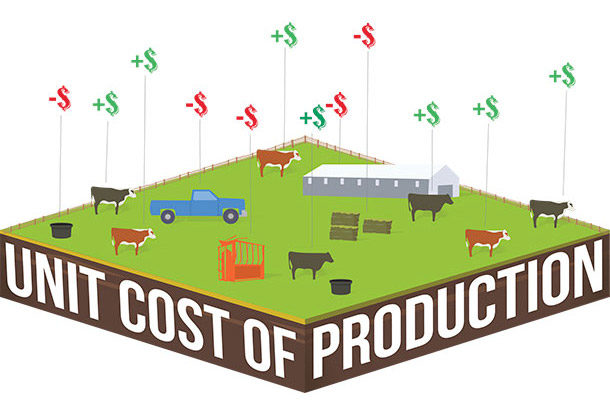Unit cost of production (UCOP) is a value based on a relationship in production or manufacturing between costs and units of product made or produced.
UCOP = costs / units produced
The relationship between the numerator (costs) and the denominator (units produced) is what drives the UCOP value. For weaned calves, the UCOP is calculated as cost per pound of calf produced. Knowing the cost to produce a pound of calf is powerful information, as it can help with marketing and management decisions. If it costs $2 per pound to produce a weaned calf, the calf must sell for more than $2 per pound to make a profit.
The power of the UCOP ratio for cow-calf producers is: Everything involved in the production of a pound of calf is represented in the numerator or denominator of the equation.
For example, if a producer wants to buy a pickup to use in the production of calves, he or she can estimate how the purchase of that new pickup will affect the UCOP in terms of cost per pound of calf produced. The same goes for the purchase of a new bull.
Evaluating the purchase of a bull in light of how many estimated pounds of calf that bull will produce in relation to his or her cost can give insight into what a producer is willing to spend.
What did it cost to produce a pound of weaned calf last year? What is it projected to cost this year? The old adage, “You can’t effectively manage what you don’t measure” is true in managing the cow-calf enterprise. The first step in calculating UCOP is to have production and financial records.
These records do not have to be complicated, but they do need to be accurate and thorough. If current management information systems don’t provide the data to run this type of analysis, consider changes that will provide the necessary records.
Dave Pratt with the Ranching for Profit School breaks ranch costs into two categories: overhead costs and direct costs. Understanding these two categories can quickly help ranchers identify differences in expenses.
Overhead costs
Overhead costs are expenses related primarily to labor, buildings and equipment. These are ongoing expenses that are part of operating a cow-calf business. These expenses don’t change much as the business grows and cows are added, until a unit of labor is added. The day a full-time person is hired to help in the operation, there will be a salary to pay. There also may be added equipment expense that will be needed for that person such as a pickup to drive, an ATV to ride, etc.
For example, let’s say a rancher has a ranch that will support 200 cows. The neighbor comes and offers to sell him an additional 200 cows and lease to the rancher the adjoining ranch. Since the ranches border each other, when the rancher buys the cows, he is planning to operate the two ranches as one place.
The day the rancher buys his neighbor’s 200 cows and integrates them in with the 200 cows he already owns, he is not likely to hire someone else or buy additional equipment to care for the 200 cows he just added. The labor and equipment used to provide care for 200 cows is sufficient to care for 400 cows.
Assuming the rancher’s overhead costs don’t increase after buying the additional 200 cows, the overhead costs per cow unit decrease to half of what they were when he had 200 cows. Now there are 400 cows to cover overhead costs where before there were 200.
Increasing cow numbers isn’t the only way to reduce overhead costs per cow unit. One can also work to reduce overhead costs per cow unit by simply reducing overheads. For many operations, overhead costs related to labor and equipment on a per-cow basis can be staggering. It’s pretty hard for cows to pay for the depreciation, interest, repairs, taxes and insurance on excessive equipment. Ranch consultant Burke Teichert terms this “waging war on costs.”
Direct costs
Direct costs are costs which increase incrementally for every unit in production. Let’s go back to the prior example, where a rancher has an opportunity to purchase his neighbor’s 200 cows. For each cow purchased, the rancher is going to expect to purchase additional vaccine, implants, eartags and protein supplement, as well as salt and mineral. When evaluating direct costs, it is good to evaluate the value of what is being received for each unit of input going into the production system.
For example, if protein supplement is being purchased for cows, how much supplement should be fed? If some protein supplement is good, is feeding more of the supplement better? For each dollar spent on an input, what is a person getting in return? If a dollar spent makes two back, it is a good idea to do more of that. If the dollar spent isn’t returning a value greater than a dollar, then that input needs to be evaluated.
The power of knowing UCOP is: It takes into account both product produced and costs. Knowing UCOP allows a manager to look forward, utilizing both present and projected input costs with production numbers to make informed management decisions.
Cow-calf producers who know UCOP numbers for their operation’s enterprises and understand the interaction between input costs and production can implement strategies to effectively manage risk and resources to meet their goals. ![]()
ILLUSTRATION: Illustration by Corey Lewis.

-
Aaron Berger
- Beef Systems, Extension Educator
- University of Nebraska – Lincoln
- Email Aaron Berger










